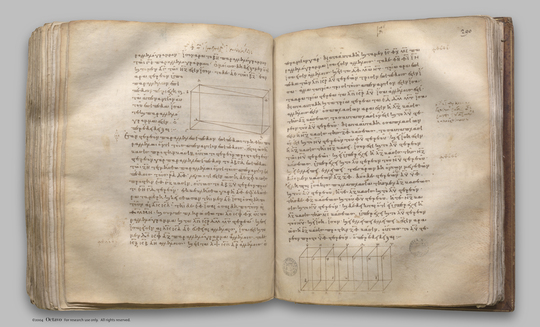index prev next | digilib folio 294

If a parallelepipedal solid be cut by a plane which is parallel to the opposite planes, then, as the base is to the base, so will the solid be to the solid.
| Ἐὰν στερεὸν παραλληλεπίπεδον ἐπιπέδῳ τμηθῇ παραλλήλῳ ὄντι τοῖς ἀπεναντίον ἐπιπέδοις, ἔσται ὡς ἡ βάσις πρὸς τὴν βάσιν, οὕτως τὸ στερεὸν πρὸς τὸ στερεόν. Στερεὸν γὰρ παραλληλεπίπεδον τὸ ΑΒΓΔ ἐπιπέδῳ τῷ ΖΗ τετμήσθω παραλλήλῳ ὄντι τοῖς ἀπεναντίον ἐπιπέδοις τοῖς ΡΑ, ΔΘ: λέγω, ὅτι ἐστὶν ὡς ἡ ΑΕΖΦ βάσις πρὸς τὴν ΕΘΓΖ βάσιν, οὕτως τὸ ΑΒΖΥ στερεὸν πρὸς τὸ ΕΗΓΔ στερεόν. Ἐκβεβλήσθω γὰρ ἡ ΑΘ ἐφ' ἑκάτερα τὰ μέρη, καὶ κείσθωσαν τῇ μὲν ΑΕ ἴσαι ὁσαιδηποτοῦν αἱ ΑΚ, ΚΛ, τῇ δὲ ΕΘ ἴσαι ὁσαιδηποτοῦν αἱ ΘΜ, ΜΝ, καὶ συμπεπληρώσθω τὰ ΛΟ, ΚΦ, ΘΧ, ΜΣ παραλληλόγραμμα καὶ τὰ ΛΠ, ΚΡ, ΔΜ, ΜΤ στερεά. καὶ ἐπεὶ ἴσαι εἰσὶν αἱ ΛΚ, ΚΑ, ΑΕ εὐθεῖαι ἀλλήλαις, ἴσα ἐστὶ καὶ τὰ μὲν ΛΟ, ΚΦ, ΑΖ παραλληλόγραμμα ἀλλήλοις, τὰ δὲ ΚΞ, ΚΒ, ΑΗ ἀλλήλοις καὶ ἔτι τὰ ΛΨ, ΚΠ, ΑΡ ἀλλήλοις: ἀπεναντίον γάρ. διὰ τὰ αὐτὰ δὴ καὶ τὰ μὲν ΕΓ, ΘΧ, ΜΣ παραλληλόγραμμα ἴσα εἰσὶν ἀλλήλοις, τὰ δὲ ΘΗ, ΘΙ, ΙΝ ἴσα εἰσὶν ἀλλήλοις, καὶ ἔτι τὰ ΔΘ, ΜΩ, ΝΤ: τρία ἄρα ἐπίπεδα τῶν ΛΠ, ΚΡ, ΑΥ στερεῶν τρισὶν ἐπιπέδοις ἐστὶν ἴσα. ἀλλὰ τὰ τρία τρισὶ τοῖς ἀπεναντίον ἐστὶν ἴσα: τὰ ἄρα τρία στερεὰ τὰ ΛΠ, ΚΡ, ΑΥ ἴσα ἀλλήλοις ἐστίν. διὰ τὰ αὐτὰ δὴ καὶ τὰ τρία στερεὰ τὰ ΕΔ, ΔΜ, ΜΤ ἴσα ἀλλήλοις ἐστίν: ὁσαπλασίων ἄρα ἐστὶν ἡ ΛΖ βάσις τῆς ΑΖ βάσεως, τοσαυταπλάσιόν ἐστι καὶ τὸ ΛΥ στερεὸν τοῦ ΑΥ στερεοῦ. διὰ τὰ αὐτὰ δὴ ὁσαπλασίων ἐστὶν ἡ ΝΖ βάσις τῆς ΖΘ βάσεως, τοσαυταπλάσιόν ἐστι καὶ τὸ ΝΥ στερεὸν τοῦ ΘΥ στερεοῦ. καὶ εἰ ἴση ἐστὶν ἡ ΛΖ βάσις τῇ ΝΖ βάσει, ἴσον ἐστὶ καὶ τὸ ΛΥ στερεὸν τῷ ΝΥ στερεῷ, καὶ εἰ ὑπερέχει ἡ ΛΖ βάσις τῆς ΝΖ βάσεως, ὑπερέχει καὶ τὸ ΛΥ στερεὸν τοῦ ΝΥ στερεοῦ, καὶ εἰ ἐλλείπει, ἐλλείπει. τεσσάρων δὴ ὄντων μεγεθῶν, δύο μὲν βάσεων τῶν ΑΖ, ΖΘ, δύο δὲ στερεῶν τῶν ΑΥ, ΥΘ, εἴληπται ἰσάκις πολλαπλάσια τῆς μὲν ΑΖ βάσεως καὶ τοῦ ΑΥ στερεοῦ ἥ τε ΛΖ βάσις καὶ τὸ ΛΥ στερεόν, τῆς δὲ ΘΖ βάσεως καὶ τοῦ ΘΥ στερεοῦ ἥ τε ΝΖ βάσις καὶ τὸ ΝΥ στερεόν, καὶ δέδεικται, ὅτι εἰ ὑπερέχει ἡ ΛΖ βάσις τῆς ΖΝ βάσεως, ὑπερέχει καὶ τὸ ΛΥ στερεὸν τοῦ ΝΥ [ στερεοῦ ], καὶ εἰ ἴση, ἴσον, καὶ εἰ ἐλλείπει, ἐλλείπει. ἔστιν ἄρα ὡς ἡ ΑΖ βάσις πρὸς τὴν ΖΘ βάσιν, οὕτως τὸ ΑΥ στερεὸν πρὸς τὸ ΥΘ στερεόν: ὅπερ ἔδει δεῖξαι. | If a parallelepipedal solid be cut by a plane which is parallel to the opposite planes, then, as the base is to the base, so will the solid be to the solid. For let the parallelepipedal solid ABCD be cut by the plane FG which is parallel to the opposite planes RA, DH; I say that, as the base AEFV is to the base EHCF, so is the solid ABFU to the solid EGCD. For let AH be produced in each direction, let any number of straight lines whatever, AK, KL, be made equal to AE, and any number whatever, HM, MN, equal to EH; and let the parallelograms LP, KV, HW, MS and the solids LQ, KR, DM, MT be completed. Then, since the straight lines LK, KA, AE are equal to one another, the parallelograms LP, KV, AF are also equal to one another, KO, KB, AG are equal to one another, and further LX, KQ, AR are equal to one another, for they are opposite. [XI. 24] For the same reason the parallelograms EC, HW, MS are also equal to one another, HG, HI, IN are equal to one another, and further DH, MY, NT are equal to one another. Therefore in the solids LQ, KR, AU three planes are equal to three planes. But the three planes are equal to the three opposite; therefore the three solids LQ, KR, AU are equal to one another. For the same reason the three solids ED, DM, MT are also equal to one another. Therefore, whatever multiple the base LF is of the base AF, the same multiple also is the solid LU of the solid AU. For the same reason, whatever multiple the base NF is of the base FH, the same multiple also is the solid NU of the solid HU. And, if the base LF is equal to the base NF, the solid LU is also equal to the solid NU; if the base LF exceeds the base NF, the solid LU also exceeds the solid NU; and, if one falls short, the other falls short. Therefore, there being four magnitudes, the two bases AF, FH, and the two solids AU, UH, equimultiples have been taken of the base AF and the solid AU, namely the base LF and the solid LU, and equimultiples of the base HF and the solid HU, namely the base NF and the solid NU, and it has been proved that, if the base LF exceeds the base FN, the solid LU also exceeds the solid NU, if the bases are equal, the solids are equal, and if the base falls short, the solid falls short. |